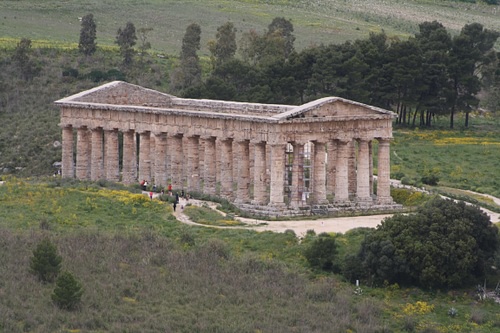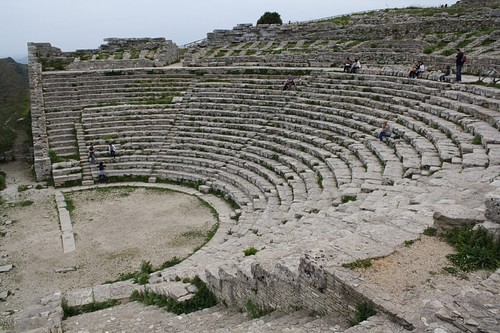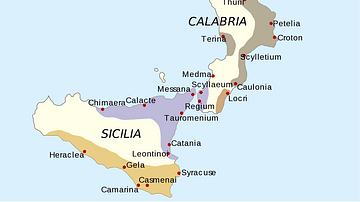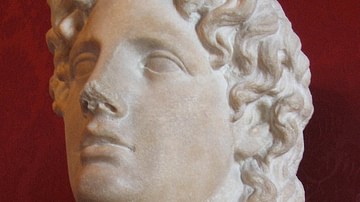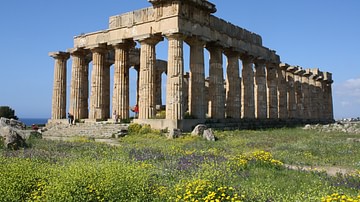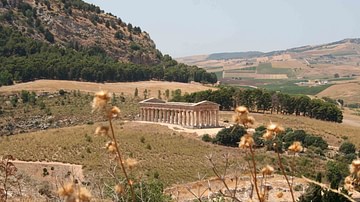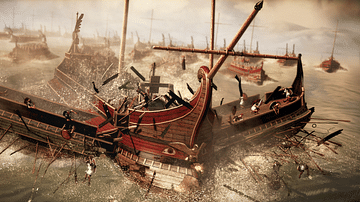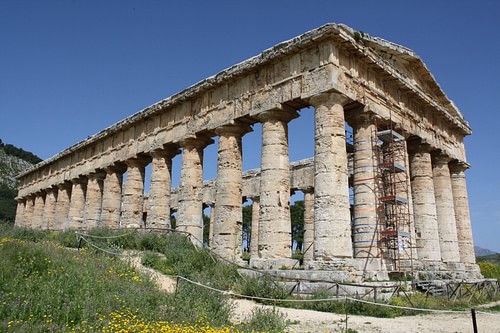
Segesta (or Egesta), located in the north-west corner of Sicily, was an important trading town from the 7th century BCE onwards. Situated on the strategically advantageous slopes of Mt. Barbaro, yet still close enough to the coast to support a trading port, Segesta established itself as the most important regional town of the Elymi people. Flourishing in the 5th century BCE, Segesta continued to hold important status as a trading centre into Hellenistic and Roman times. Today, the site has two of the best-preserved Classical monuments anywhere and they are impressive testimony of Segesta's one-time prosperity - a 5th century BCE Doric temple which, at least externally, is reasonably intact and an equally well-preserved 3rd-2nd century BCE theatre which provides its audience with a stunning view towards the nearby Gulf of Castellamare.
In Mythology
One of the symbols often associated with Segesta is a dog, which is seen, for example, on 4th century BCE coins. The animal may refer to the founding myth that describes a dog as the personification of the river god Crimisus. It was he who fell in love with a local nymph (Egesta), and their resulting offspring, Egesto, was credited with being the founder of the city. In the Roman mythology which sought to link Segesta with her ancient Roman origins, the Trojan hero Aeneas stopped off on Sicily during his long wanderings from Troy to his final destination Italy and the founding of Rome. Aeneas, then, according to Virgil, founds Acesta (later to become Segesta). Aeneas escaping Troy is portrayed on bronze coins from Segesta minted during the reign of Augustus.
In yet another version of the mythical events surrounding the founding of the city, the principal character is one Aegesto (or Aceste), who was born in Sicily to a Trojan mother. Aegesto returned to Troy when he was an adult, but following the sacking of the city in the Trojan War, he and a group of survivors returned to Sicily. First establishing themselves at Erice, Aegesto later relocated, setting up a new city at Segesta.
Historical Overview
Origins
According to Thucydides in his History of the Peloponnesian War (VI 2), Egesta and nearby Eryx were founded by colonists from Troy who came sometime in the 2nd millennium BCE and who called themselves the Elymi and who spoke their own language - Elymian - and later also Greek. Other possible early colonists include peoples from Liguria in northern Italy and Puglia in the south of the Italian mainland. From the 7th century BCE Segesta, to use its more familiar Latin name, became an established Greek polis or city-state and the regional political capital. Trade flourished, Doric architecture from Greece was assimilated, there was an independent army and even a mint. An emporium on the coast allowed for the trade and export of locally produced goods such as wine, corn, wool, walnuts, wood, and olives. Segesta did not have everything her own way, though. The construction of fortification walls suggests a significant threat from enemy city-states and between 580 and 576 BCE, the rivalry with Selinus (Selinunte) on the southern coast of the island finally broke out in war.
Zenith
In the mid-5th century BCE Segesta reached the zenith of its prosperity and importance. This brought with it an end to the friendly relations which had finally been established with Selinus, and, in c. 458 BCE (traditional date), a treaty of mutual cooperation with Athens. In 416 BCE rivalry with Selinus resulted in another war and Athens was called upon (and paid) to give military aid. In addition to a financial incentive, the threat of the east coast polis Syracuse dominating Sicily and becoming an even more powerful ally of Sparta - Athens' long-time enemy - was another argument used to encourage Athens to increase her sphere of influence. In the spring of 415 BCE, Athens responded to Segesta's request by sending the general Alcibiades and a fleet of 60 ships. However, the help never arrived, as the fleet was re-directed to a disastrous war directly against Syracuse with Segesta even sending 300 cavalry in support. Syracuse was the most powerful city on Sicily and ally of Selinus, and it was perhaps her defeat that really motivated Athenian interest in Sicily. Following the Athenian defeat and as an alternative strategy for self-preservation, Segesta appealed to Carthage, but the response was ambiguous - Selinus was sacked in 409 BCE but the Carthaginians, eager to maintain their grip on Mediterranean trade, firmly planted themselves as masters of western Sicily and established a garrison at Segesta. In 405 BCE a treaty was signed between Syracuse and Carthage to divide up the island between these two dominant parties.
Hellenistic & Roman Times
Things got even worse for Segesta when the Syracusan tyrant Agathocles sacked the city in 307 BCE. The changing of the town's name to Diceopolis was one of the lesser indignities the local population had to put up with under this brutal ruler. The new master was not in charge for long, though, as Carthage quickly re-asserted control of the region. With the first Punic War (264-241 BCE), Segesta once more became embroiled in bitter regional politics and power again changed hands, so that by 210 BCE the whole of Sicily became a province of the new masters of the Mediterranean: the Romans.
Under Roman rule Segesta once more enjoyed a period of prosperity. The town expanded its territory and was, in 225 BCE, given the status of civitas immunis et libera, which resulted in fewer taxes and an increase in political autonomy. Indicators of this return to the good times are the 2nd century BCE theatre, agora, bouleuterion (seat of the town council), and city walls. However, from the late 1st century CE the town begins a slow decline and recedes from the historical scene, to be finally abandoned from the 2nd century CE in favour of the nearby Aquae Segestanae.
Archaeological Remains
The Temple
Located on a 304 metre-high hill nestling between Mt. Barbaro and the Pispisa massif, the 5th century BCE temple commands an impressive view of the surrounding countryside. Built probably c. 417 BCE upon an earlier cult building, the Doric style temple is almost complete in its external aspect, only the wooden and tile roof is missing. None of the interior structure survives, although, in fact, the temple was never completed even in ancient times, and the inner foundation works were still in progress when the project was mysteriously abandoned. The temple was built using travertine from Alcamo and measures around 26 x 61 metres. There are six columns on each façade and 14 columns along the length, all standing on a three and a half step base (crepidoma), and each column stands 9.33 metres high. Decoration is provided by alternate triglyphs and blank metopes.
Quite why an Elymian site would reproduce so precisely the architecture of a Greek Doric temple is much debated amongst scholars. So too, is exactly which god or cult the temple was dedicated to. The temple was probably abandoned mid-construction when Carthage took control of the territory. Apart from the missing interior cella, the outer entrance steps, column fluting, and base blocks between the columns are also missing. A 4th century BCE Punic tomb placed within the temple is also indicative that it no longer functioned as a place of worship.
The temple has undergone some modern restoration using steel bars for support and materials such as resins and rubber to fill in missing pieces. The whole structure has also been treated with a water-resistant solution to ensure its continued preservation against the elements. Nevertheless, the structure is sufficiently intact to give the visitor one of the best views of what an ancient Greek temple looked like in its original state, albeit minus the colourful paint scheme.
The Theatre
The theatre, nestling in the side of Mt. Barbaro, today commands a spectacular view of the Gulf of Castellamare. First built from the late 4th to early 3rd century BCE, the theatre as it is seen today dates to the 2nd century BCE. Originally it had 29 rows of seats (the lower 21 survive) divided vertically into seven sections by access steps. The capacity would, therefore, have been around 4,000 spectators. The theatre is supported by a containing wall constructed of limestone blocks. The orchestra, scene building (once decorated with scenes connected to the pastoral god Pan), and entrances (paradoi) on either side have been lost. The theatre continues to host theatre events and Greek dramas throughout the summer months.
The Fortifications
Mt. Barbaro also had extensive fortifications which were begun in the 5th century BCE and extended over the centuries to include eleven square towers and up to five gates. Finds near the walls include some 120 stone missiles for use with catapults. Used from the 4th century BCE, these would have been mounted on the wall ramparts. Over time the fortifications retreat higher up the hill with the lower gates being abandoned, so that only the upper part of the town was defensible by the 1st century CE. These newer defences included 13 towers (the highest being 6 metres high) and two gates.
